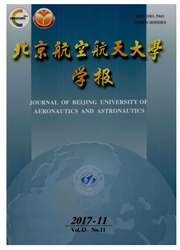

 中文摘要:
中文摘要:
在不同的迎角范围内,通过求解雷诺平均N-S(Navier-Stokes)方程模拟了雷诺数Re=2.4×105下,鸭翼和机翼前缘后掠角均为50°的近距耦合鸭式布局简化模型的绕流结构,并与该模型的风洞测力和水洞流动显示实验结果进行了比较和验证,分析了鸭翼涡和机翼涡在不同迎角下的演变过程.根据鸭翼的不同作用效果,将迎角范围划分为3个区域,分析了各个迎角范围内的主要作用机制.鸭翼涡与机翼涡的演变和干扰过程虽然极为复杂,但可将其概括为诱导、卷绕和破裂作用.分析结果表明:中大迎角以后鸭翼涡都会对主翼涡产生有利影响,尤其在中大迎角下,卷绕起到了主导作用,鸭翼涡产生的增升效果也最好.
 英文摘要:
英文摘要:
Numerical investigation on the vortical structure was carried out on a simplified close-coupled canard configuration with a 50° swept delta wing and a 50° swept delta canard at various angle of attack(AOA)by solving Reynolds averaged Navier-Stokes(N-S) equations at 2.4×105 Reynolds number.The vortex evolution was analyzed by comparison with wind tunnel force measurement and water tunnel dye visualization.The dominant interaction mechanism was figured out in three AOA regions which were classified by the canard effect.Although the vortical flowfield are complex,the vortex interaction effect could be cataloged into three mechanism named induction,convolution and burst.The analysis indicates that the canard vortex would perform a favorable impact on the main wing vortex especially at the medium and high AOA region,where the convolution effect is dominant and the lift is enhanced most significantly.
 同期刊论文项目
同期刊论文项目
 同项目期刊论文
同项目期刊论文
 期刊信息
期刊信息
